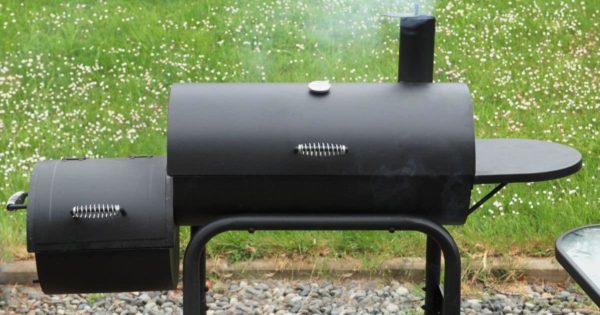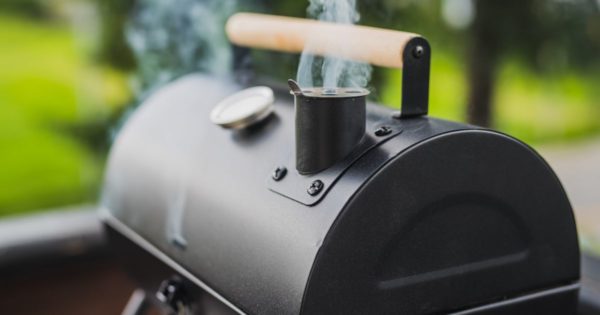Learning how to season a smoker can be a tricky process. That’s why we’ve prepared this guide for you.
Purchasing a brand-new smoker is surely a thrilling moment. You have all these ideas in your head that are now simply within your grasp.
But if you’re struggling to choose a smoker, read our guide on the Best Vertical Smoker and Grill.
If you’re someone who’s into cooking, you probably would’ve heard of “seasoning.”
That’s pretty much it! Although not entirely the same logic but very similar. It’s more like marinating the meat before you cook it.
So, seasoning simply prepares your smoker to make it BBQ-ready.
Let’s find out what we mean by that.
Seasoning a Smoker
As far as “seasoning a smoker” goes, you bet it’s an extremely vital stage. It’s like an initiation of the smoker before you put it to use.
Contrary to what “seasoning your food” entails, “seasoning your smoker” refers to treating the smoker before using.
It cleans the interior of the smoker using heat and oil.
You coat the smoker, its interior, and its component by making use of oil. This step is very vital since it helps prevent contamination and rust.
Also, you need to make sure that you dry out the oil before you heat the chamber.
If you’ve done your bit of research, you must be aware that there are various methods of seasoning the smoker.
In this guide, we’ll help you learn how to season a smoker most easily and effectively.
Let’s begin.
How to Season a Smoker? Detailed Steps

Before you begin the seasoning process, make sure you’ve got the following things ready to go.
- Smoking wood.
- Clean fabric.
- Cooking oil.
- Mild dish soap.
- Water.
Once you have these items ready, continue with the following steps.
Note: Be extra careful if you’ve purchased an electric or gas smoker.
Avoid messing with the electrical heating components. There’s no need to apply cooking oil to these areas.
With propane smokers, be wary of the gas lamps. The application of oil in these regions can turn out to be disastrous.
Read and follow the seasoning instructions carefully before proceeding.
Take apart the smoker.
By that, we don’t mean break the smoker. Simply take apart its components carefully. We recommend you do this before assembling the smoker.
Doing so will allow you easy access to each component of the smoker. In contrast, taking apart an already assembled smoker is a waste of time.
This way, you’ll be able to clean the components much better and save time and energy.
In case you aren’t able to remove every component, don’t fret! As long as you have access to the smoker grates and clean that, all is good.
Thoroughly wash the Inner Chamber.
Take the water and mild dish soap and give the pans, grates, and chamber body a thorough cleaning.
Once done, make sure you don’t leave excess soapy water anywhere inside the chamber. Use a clean fabric to wipe it away.
Plus, practice caution so you don’t leave any scratches.
So, a thorough wash, wiping until dry, and no scratches: These are the takeaways.
Note: We recommend using mild soap due to its degreasing features. It’ll get rid of any manufacturing grime or oil left over.
Application of Cooking Oil.
Once you’re done cleaning the inner chamber, it’s time to apply cooking oil.
Take a clean tissue or fabric and pour cooking oil on it. Use that to coat a thin protective layer of cooking oil over the surfaces of the smoking grate. If you think that’s a messy process, you can even make use of the cooking spray.
The application of cooking oil is much easier in the case of an unassembled smoker. That way, you can coat every corner, edge, and surface within the chamber.
Assembling the Smoker.
That’s why we stressed that it’s better to have your smoker unassembled. Disassembling an assembled smoker just to assemble it again is a cumbersome process. Using the instruction manual, make sure to follow the instructions as you assemble the smoker.
The surface of the smoker will be slippery since you’ve just applied oil to it. So, be careful not to let it slip. Don’t hold onto it too tightly, or else you’ll wipe the oil away.
For the assembly process, we advise wearing rubber gloves. They will make sure you don’t wipe away the protective coating of oil you’ve just applied.
Oiling the exterior.
Yes, you need to oil the outside as well. Why? That’s because doing so will help against weathering and help avoid rusting.
To oil, the outside of the smoker, a thin coat of vegetable oil is enough.
Placing the Water Pan.
Place the empty water pan below the smoker, preferably at its foot. Make sure to leave the top and bottom vents wide open.
In case you didn’t know, often, some prefer adding beer to the water pan. That’s because doing so helps in the infusion of flavor.
Turn up the heat.
The last and final step in “how to season a smoker” is to fire it up. But make sure that you know how to control the temperature of a smokerbefore proceeding.
The trick here is to increase the temperature of the smoker gradually. Go ahead and turn it on.
As mentioned earlier, increase the smoker’s temperature after 5-10 minutes. Continue raising the heat until you’ve reached the maximum temperature of the smoker. On reaching the max temp, maintain that internal temperature, and leave the smoker running for 2-3 hours.
Why Must You Season Your Smoker?

As much as you wish to forego seasoning your barbeque smoker, we strictly advise that you take the time and effort and properly season the smoker.
When you go purchase a brand-new smoker and bring it home, it’s coated with contaminants and debris. Believe it or not, these smokers aren’t as clean as you’d like them to be.
Anything from tiny wood and cardboard pieces to metal shavings and dust covers the surface of these unseasoned smokers.
Moreover, manufacturers even use a blend of oil and smoker components to coat the smokers. Such blends help preserve the integrity of the smoker and prevent it from rotting as it sits on the shelves.
Thus, seasoning gets rid of all such preservatives, contaminants, and unwanted debris. It even removes open pores from the surfaces and trays of the smoker. Plus, seasoning plays a vital role in prolonging the life of your smoker and preventing rusting.
So, it’s evident that you must season your smoker before using it.
What Type of Wood Should I Use for Seasoning?
Choosing the right type of wood is among the top aspects users are struggling with.
Sure, when it comes to BBQing, the type of wood you use matters quite a lot. It can make a whole lot of difference in how your meat will turn out.
Seasoning can take about three hours to complete the “full cooking cycle” process. That’s why we recommend using a type of wood that burns slowly and lasts long.
At the same time, there’s no wrong choice when choosing wood for seasoning your smoker. Traditional woods do wonders when seasoning a smoker. It’s capable of infusing an unusual flavor or aroma within the inner chamber. For such purposes, we highly recommend using wood such as Oak.
FAQs
What type of oil should I use to season my smoker?
When seasoning a smoker, you must make use of oils that have a high concentration of polyunsaturated fats.
That includes safflower oil, flaxseed oil, grapeseed oil, and palm sunflower oil. Such types of oils have lower smoking points.
Do I need to season the smoker every time?
Seasoning is recommended only for brand-new smokers. Once properly seasoned, you’re all set.
Although cumbersome, it’s really good to season your smoker two to three times yearly. Other than that, properly wipe away leftover meat or grease after every use to prevent disgusting build-ups.
Does oiling the exterior of the smoker help prevent rust?
Although a bit odd, oiling the exterior before cooking helps prevent the formation of rust. You simply need to oil the exterior before you heat the smoker.
Summary
Barbequing takes much more than just smoking your meat on the smoker. Knowing how to season a smoker brings you one step closer to perfecting your BBQing skills.
Please make sure you carefully follow the points we’ve mentioned. These steps are sure to help you properly prepare your smoker and make it long-lasting.
Plus, get one of these Grill Covers for your BBQ smoker while you’re at it.
We hope this has been a great learning experience for you. Don’t forget to share this guide with your family and friends.
Last Updated on November 10, 2022 by Judith Fertig
Leave a Reply